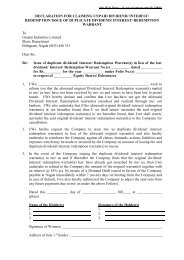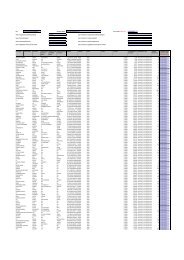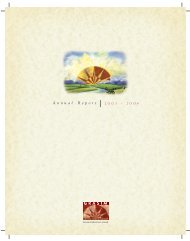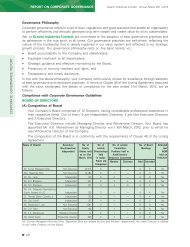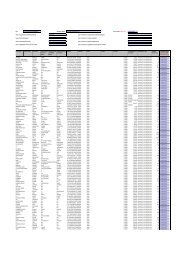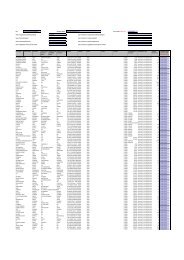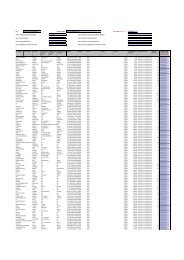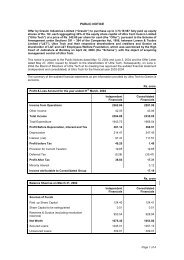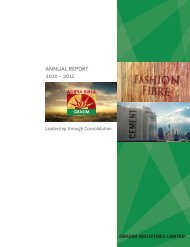2010-11 - Grasim
2010-11 - Grasim
2010-11 - Grasim
You also want an ePaper? Increase the reach of your titles
YUMPU automatically turns print PDFs into web optimized ePapers that Google loves.
ULTRATECH CEMENT LANKA (PVT) LIMITED<br />
Defer<br />
erred<br />
red Tax<br />
Deferred tax is recognised in respect of temporary differences between the carrying<br />
amounts of assets and liabilities for financial reporting purposes and the amounts<br />
used for taxation purposes.<br />
Deferred tax assets and liabilities are offset if there is a legally enforceable right to<br />
offset current tax liabilities and assets, and they relate to income taxes levied by the<br />
same authority on the same taxable entity.<br />
A deferred tax asset is recognised only to the extent that it is probable that future<br />
taxable profits will be available against which the temporary differences will be<br />
utilised. Deferred tax assets are reviewed at each reporting date and are reduced to<br />
the extent that it is no longer probable that the related tax benefit will be realised.<br />
Deferred tax liabilities are measured at the tax rates that are expected to apply to<br />
the year when the liability is settled, based on tax rates (and tax laws) that have<br />
been enacted or substantially enacted at the reporting date.<br />
4. CASH FLOW STATEMENT<br />
TEMENT<br />
4.1 Cash and cash equivalents<br />
The cash flow statement has been prepared using the “indirect method”.<br />
Cash and cash equivalents are defined as cash in hand and demand deposits, readily converted to<br />
known amounts of cash and subject to insignificant risk of changes in value.<br />
Interest paid are classified as operating cash flows for the purpose of presentation of Cash Flow<br />
Statement and reported based on the indirect method.<br />
4.2 Capital al commitments and contingencies<br />
Capital commitments and contingent liabilities of the Company are disclosed in the respective Notes to<br />
the financial statements.<br />
5. EARNINGS PER SHARE<br />
The Company Group presents basic earnings per share (EPS) for its ordinary shares. Basic EPS is calculated<br />
by dividing the profit or loss attributable to ordinary shareholders of the company by the weighted average<br />
number of ordinary shares outstanding during the period.<br />
6. EVENTS OCCURRING AFTER BALANCE SHEET DATE<br />
All material post balance sheet events have been considered and where appropriate adjustment to or<br />
disclosures have been made in the financial statements.<br />
7. SEGMENT REPORTING<br />
A segment is a distinguishable component of the Group that is engaged either in providing products or<br />
services (business segment), or in providing products or services within a particular economic environment<br />
(geographical segment), which is subject to risks and rewards that are<br />
different from those of other segments. Segmental information is not presented as the Company’s<br />
management and internal reporting structure does not facilitate the extraction of the requested information.<br />
8. NEW STAND<br />
ANDARDS<br />
ARDS AND INTERPRETATIONS TIONS NOT YET ADOPTED<br />
The Institute of Chartered Accountants of Sri Lanka issued a new volume of Sri Lanka Accounting Standards<br />
which will become applicable for annual periods beginning on or after 1 st January, 2012. Accordingly these<br />
Standards have not been applied in preparing these financial statements as they were not effective for the<br />
period ended 31 st March, 20<strong>11</strong>.<br />
The Company is currently in the process of evaluation the potential effect of these Standards on its financial<br />
statements and the impact on the adoption of these Standards have not been quantified as at the reporting<br />
date.<br />
122



